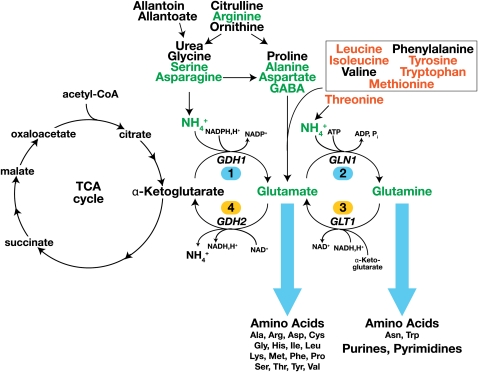Figure 1 .
Schematic diagram of the main pathways of nitrogen metabolism. The entry routes of several nitrogen sources into the central core reactions are shown. The class A preferred and class B nonpreferred nitrogen sources are in green and red text, respectively. The nitrogen of preferred nitrogen sources is incorporated into glutamate, and the resulting carbon skeletons are shunted into pyruvate and α-ketoglutarate. Nitrogen from branched-chain amino acids, aromatic amino acids, and methionine (within box) is transferred to α-ketoglutarate by transaminases forming glutamate; the resulting deaminated carbon skeletons are converted to noncatabolizable and growth-inhibitory fusel oils (Hazelwood et al. 2008). Nitrogenous compounds are synthesized with nitrogen derived from glutamate or glutamine as indicated (blue arrows). Central anabolic reactions 1 and 2 are catalyzed by NADPH-dependent glutamate dehydrogenase (GDH1) and glutamine synthetase (GLN1). Central catabolic reactions 3 and 4 are catalyzed by NADH-dependent glutamate synthase (GLT1) and NAD+-linked glutamate dehydrogenase (GDH2). For detailed descriptions of the pathways, the reader is referred to the SGD (http://pathway.yeastgenome.org/) or KEGG (http://www.genome.jp/kegg/pathway.html) databases.

